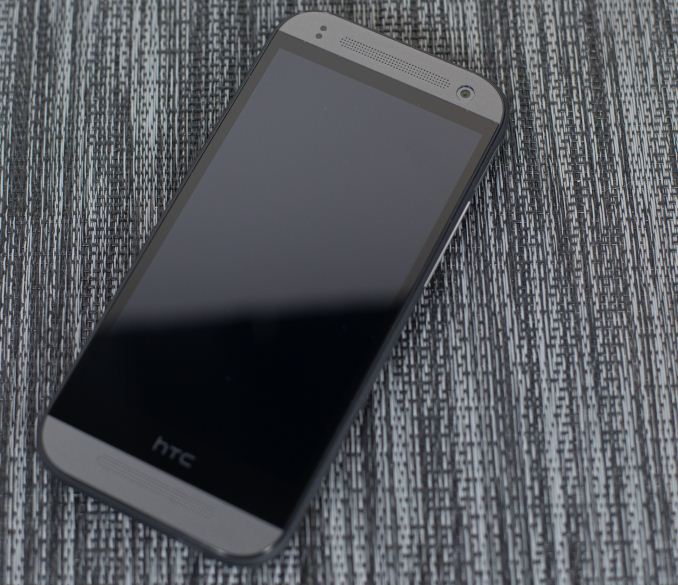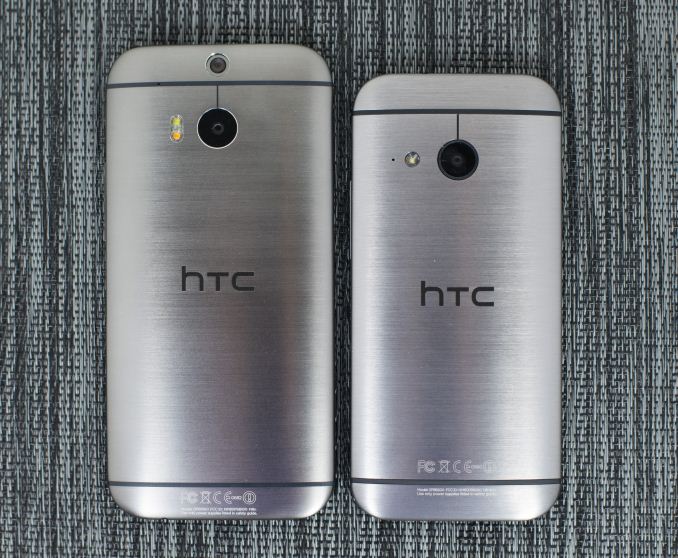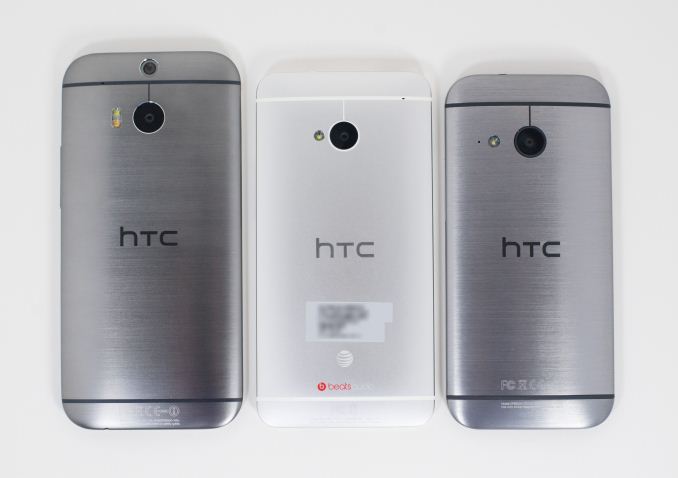HTC One mini 2 Review
by Anand Lal Shimpi & Joshua Ho on May 26, 2014 3:00 AM EST- Posted in
- Smartphones
- HTC
- Mobile
- One mini 2

Last year around this time, HTC had yet to release a mini version of its flagship phones. As OEMs continued to push bigger and bigger displays into bigger phones, there was a distinct push for a phone that had flagship specifications, but without the size that normally entailed such flagship specifications in the Android space. HTC then proceeded to launch the One mini, a phone that was the size that everyone had been asking for, but just wasn’t the same as its larger cousin. While there are now phones around the size of the One S that have flagship specs, the One mini was a distinctly midrange device, with a number of concessions made to reach a midrange price.
Of course, that was the past. Today we’re looking at the successor to the One mini. Unfortunately, for those that want everything in a One (M8) repackaged to fit into a phone the size of a One S, this is not that phone. However, the bigger question is how well this phone fits into the mid-range spectrum, and how well it compares to the competition. To this end, HTC seems to hope that better design and the halo effect from the One (M8) will differentiate the One mini 2 from the rest of the competition.
As always, the most immediate impression that one gets is from holding the phone, even before it’s turned on. In this respect, the One mini 2 is easily one of the best in its class. While it isn’t the nearly all-metal design of the M8 (50% vs 90% metal, excluding display), there’s very little plastic on the back cover, only a bit of the edge where the back cover interfaces with the rest of the phone. It’s somewhat similar to the One (M7) in this regard, although the One mini 2 has more aluminum on the side walls. The button layout is also the exact same setup as the One (M7), with a power button on the top left, 3.5mm jack on the top right, volume rocker on the right side of the phone, and the microUSB 2.0 port on the bottom right. The speaker grilles share their lineage with the One mini and One (M7), as does the layout of the speaker grilles, front facing camera, and the proximity/light sensor.
Overall, the material design and industrial design of the One mini 2 far exceeds almost anything else on the market. It’s undeniable that while some concessions have been made compared to the One (M8), in some ways the industrial design is better on the One mini 2. HTC has done a great job designing this phone.
In the hand, the size of the phone is close to the One (M7). It’s definitely a big larger in the hand when compared to the original One mini, although I’m not too sure if this is a significant difference. For those that see the iPhone 5 and 5s as the absolute largest phone that they’re willing to tolerate, this may be too much, although those that have no trouble with the Moto X and other similarly sized devices will be right at home here.
Moving past basic hardware impressions, the One mini 2 is in many ways a side-grade from the One mini. The SoC is still under the Snapdragon 400 branding, but is now a quad core Cortex A7 rather than a dual core Krait. The amount of RAM stays the same, as does display resolution. The camera is now a standard 13MP sensor with F/2.2 optics, although the front facing camera is borrowed from the One (M8) and is a good jump up from the 1.6MP camera from the One mini. A table of the hardware specifications can be seen below, along with a comparison to the One (M8) and One mini.
| HTC One mini 2 | HTC One (M8) | HTC One mini | |
| SoC | MSM8926 1.2 GHz Snapdragon 400 | MSM8974ABv3 2.3 GHz Snapdragon 801 | MSM8930 1.4 GHz Snapdragon 400 |
| RAM/NAND | 1 GB, 16GB NAND + microSD | 2GB LPDDR3, 16/32GB NAND + microSD | 1 GB LPDDR2, 16GB NAND |
| Display | 4.5” 720p LCD | 5” 1080p LCD | 4.3" 720p LCD |
| Network | 2G / 3G / 4G LTE (Qualcomm MDM9x25 UE Category 4 LTE) | 2G / 3G / 4G LTE (Qualcomm MDM9x25 UE Category 4 LTE) | 2G / 3G / 4G LTE (Qualcomm MDM9x15 UE Category 3 LTE) |
| Dimensions | 137.43 x 65.04 x 10.6mm, 137 grams | 146.36 x 70.6 x 9.35mm max, 160 grams | 132 x 63.2 x 9.25 mm, 122 grams |
| Camera | 13MP rear camera, 1.12 µm pixels, 1/3.06" CMOS size, F/2.2. 5MP f/2.0 FFC | 4.0 MP (2688 × 1520) Rear Facing with 2.0 µm pixels, 1/3" CMOS size, F/2.0, 28mm (35mm effective) and rear depth camera, 5MP f/2.0 FFC |
4.0 MP (2688 × 1520) Rear Facing with 2.0 µm pixels, 1/3" CMOS size, F/2.0, 28mm (35mm effective) no OIS 1.6 MP front facing |
| Battery | 2100 mAh (7.98 Whr) | 2600 mAh (9.88 Whr) | 1800 mAh (6.84 Whr) |
| OS | Android 4.4.2 with Sense 6 | Android 4.4.2 with Sense 6 | Android 4.4.2 with Sense 5.5 |
| Connectivity | 802.11a/b/g/n + BT 4.0, USB2.0, GPS/GNSS, MHL, DLNA, NFC | 802.11a/b/g/n/ac + BT 4.0, USB2.0, GPS/GNSS, MHL, DLNA, NFC | 802.11a/b/g/n + BT 4.0, USB2.0, GPS/GNSS, MHL, DLNA |
| SIM Size | NanoSIM | NanoSIM | MicroSIM |
The One mini 2 should be priced similarly to the original One mini at launch. HTC tells us to expect the One mini 2 to retail at £360 - £370.












76 Comments
View All Comments
flyingpants1 - Monday, May 26, 2014 - link
Thought so. Inferior device at a high price point. Get a Nexus 5 instead.piroroadkill - Monday, May 26, 2014 - link
Every single time. Only Sony gets it - the Xperia Z1 Compact doesn't use a second-rate SoC or camera compared to the Z1. It's a full-fat version, just smaller.Chaitanya - Monday, May 26, 2014 - link
Sony did everything right that neither Samsung or HTC have been able to do with their mini versions of flagship smartphones.teiglin - Monday, May 26, 2014 - link
Couldn't agree more. I finally bit the bullet and bought an imported Z1 Compact about a month ago and am very happy with it. I don't have the words to express my disappointment that Sony's example is not being followed, nor that American operators aren't interested in picking up a great device like the Z1 Compact.On the topic of the One mini 2 itself, it seems like a perfectly decent phone, but you guys really hit it on the head with the "two worlds" thing--on the one hand, the same money gets you a G2, which is still a great phone by any account; on the other, it has the specs of a Moto G, which is half as much. I love HTC's industrial design, but it is hard to argue that the One mini 2 is competitive.
seanleeforever - Monday, June 2, 2014 - link
agreed.and i might also add LG L6, a phone that you can purchase right off the ebay for 120 (or 100 if it is on the ebay daily deal). that has almost the same spec as the original one mini (actual performance is better since the skin isn't as heavy). i recently get one and my god the battery is godly. i can go with 3 days (as in 3 day+ 3 night) on a charge when using it to check email, facebook and occasionally web browsing. on comparsion my N4, if used the similar manner, would be dead before the second day.
with that all said, there isn't a single reason to pay 400 dollars for a mini 2 over the aluminum body when you can get L6 for 100 dollars, or Note 3 neo for about 360 dollars.
ColinByers - Monday, September 29, 2014 - link
HTC One mini 2 is really good, but I would recommend going for the flagship HTC One M8 instead, it is currently the best phone on the market. /Colin from http://www.consumertop.com/best-phone-guide/synaesthetic - Monday, May 26, 2014 - link
I don't understand why nobody except Sony seems to understand this concept. Both HTC and Samsung cripple the specs of their "mini" variants. Why... why would you do that? Don't you understand that some people just don't want monster screens, but still want top-tier performance? :/Spunjji - Tuesday, May 27, 2014 - link
This, a thousand times!AnnonymousCoward - Wednesday, May 28, 2014 - link
If the Z1 is so high-end, then why is the camera latency so bad?pjcamp - Thursday, May 29, 2014 - link
Everything has its problems.Sony's problem is that they can't seem to figure out how to sell things in the US.